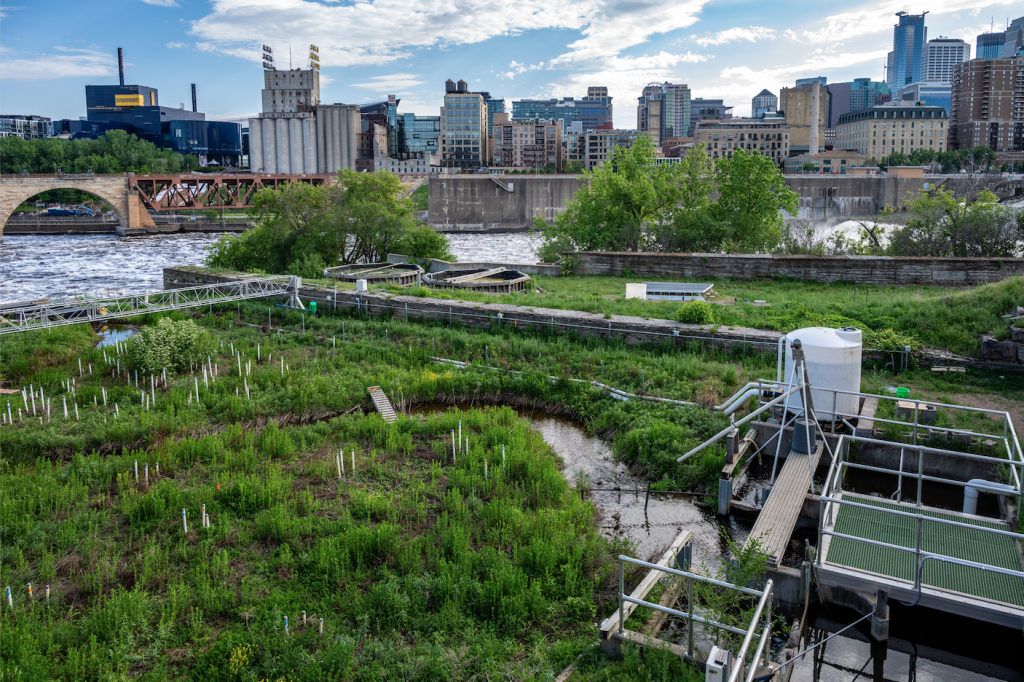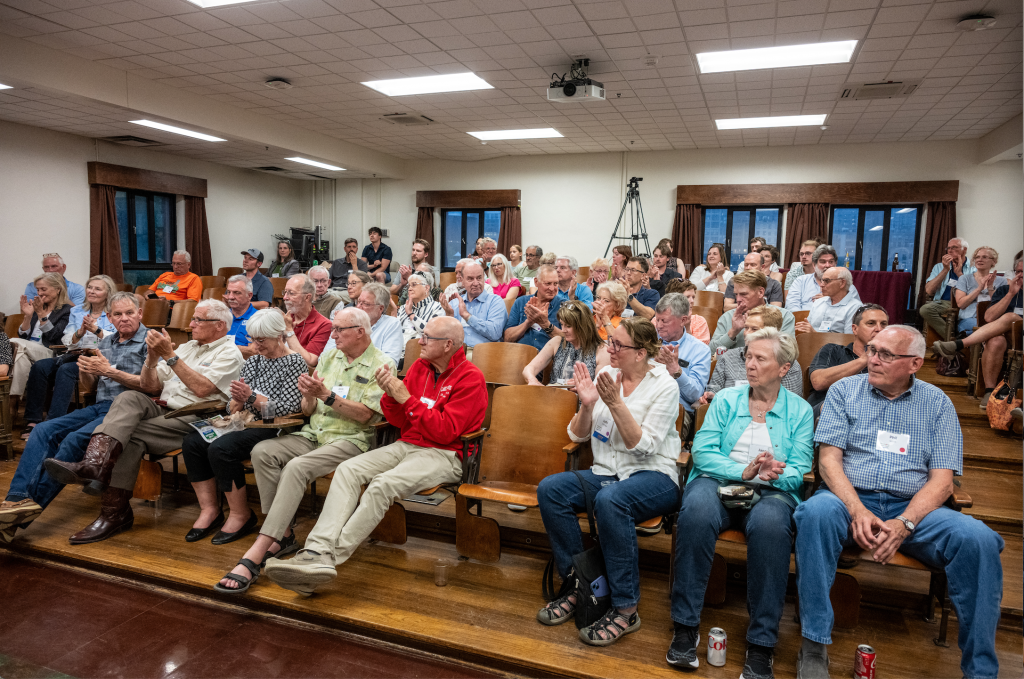
On May 17th, over 100 of the lake leaders from across Minnesota gathered at the Saint Anthony Falls Lab to see some of the latest science on zaqwuatic invas9ve species, algae blooms, shoreline ecology and wake and prop thrust impacts. They also had a chance to connect with eachother, share information and efforts, and build the relationships that are so critical to protecting Minnesota’s lakes and rivers into the future. The event was hosted by MLR with support from the State of Minnesota, Kowalski’s Markets and Minnesota Native Landscapes.

Below are MLR Executive Director Jeff Forester’s Comments
Welcome everyone to the Saint Anthony Falls Lab at the University of Minnesota. Thank you for taking the time to celebrate and connect with us at this beautiful facility on the Mississippi River. What a setting.
The people gathered here represent what writer Mark Casey named “The Guardians,” in his Lake Country Journal article Loving Our Lakes to Death.
Guardians are the people who take it upon themselves to protect and restore our lakes and rivers. You are all guardians, but you come from many different jurisdictions. Here tonight are business leaders, scientists, political leaders, government resource managers, Tribal leaders, lake association leaders, and other nonprofit leaders. You are the partners that come together to prevent or manage Aquatic Invasive Species, to restore or protect shorelines, reduce boating impacts on lakes and rivers, wildlife and lake sediments, to prevent runoff pollution into our waters.
Guardians from many different jurisdictions are weaving together programs and capacities and information to protect water in Minnesota. In my role at MLR I connect with many of you in these different jurisdictions and see the work you are doing. It gives me hope and hope gives me energy to redouble my efforts. I want to share that energy with you tonight.
Tonight is not only a celebration of the work you do and a thank you for doing it, but an opportunity to build relationships among you – to celebrate this network of Water Guardians. It is an opportunity to deepen existing relationships and generate new partnerships. Protecting lakes and rivers in Minnesota is far too big a job for any single organization.
Because we must rely upon each other to be successful, it is work that inspires gratitude. I am personally grateful to each of you for what you do.
Thank you.
Minnesota’s lakes and rivers are the envy of the world. They are the core of our state identity, the foundation of our vibrant recreation economy, and the center pillar of our outdoor way of life. Everyone in Minnesota benefits from our water resources.

Water Connects Us All.
Minnesota is one of two places in the world where three continental-sized watersheds meet. We are gathered here tonight at the top of the navigable waters of the Mississippi.
The Dakotah name for this place was Owamniyomni. The Owamniyomni flows across America to the Gulf of Mexico. Minnesota’s Red River flows north to the arctic ocean, the Great Lakes waters flow from the Laurentian Divide east to the North Atlantic.
Minnesota is literally the Headwaters of the Eastern Half of the United States.
The work we do to restore and protect Minnesota’s resources impacts much of the continent.
This is not an aspirational goal, but a statement of fact. Minnesota’s role is not just about the quality of the water that flows out of our state, but the ideas, research, programs, partnerships and work we do here.
Three days ago we received an email that read, in part, “Cobbossee Lake Association in southern Maine has modeled a lot of what we do through your work.” Late last week we received an email from a Coalition of Lake Associations in Michigan looking for direction on our organizing model. We also heard from a Wisconsin Lake association that wants to carry our Lake Steward Program.
In Minnesota there is no agency, governmental unit, or department solely focused on protecting or restoring our lakes and rivers; no one organization manages lake health holistically. Authority and responsibility for protecting water is divided among federal, state, tribal, county and local governments. One problem with this model is that water flows around and between these regulatory silos.
But Minnesota has one other asset – an engaged citizenry. Minnesota has over 500 lake associations. With an average membership of about 200, there are over 100,000 lake association members in Minnesota. More people belong to a lake association in Minnesota than any other non-profit or civic organization in the state. These local groups, positioned on the shore of our lakes and rivers, can fill the silos. Lake Associations are the eyes on the lake, the ultimate boots on the ground. The motivated local stewards of the public resource.
IF TAKEN COLLECTIVELY – Lake Associations Are the Largest, Most Committed and Most Generous Conservation organization in Minnesota. Lake associations spend close to $10 million annually on their missions and commit over 1.25 million volunteer hours. they spend over $500 thousand a year on fish stocking. If you like to fish, thank a lake association.
However, Minnesota’s lake associations are not fully unified. Without unity, we lack power. And power is what we need to protect the lakes and rivers we love. With unity, Minnesota’s lake associations have the potential to be the strongest environmental and preservation group in the state. Minnesota Lakes and Rivers (MLR) is best positioned to unify all lake association members and close the gaps preventing long-term protection of our most valuable resource – our water.
MLR has two focus areas:
- Unify all of Minnesota’s 520 lake associations and their members into a single voice,
- Promote science-based Best Practices, good governance, political competence and strategic advocacy to elevate the capacity and impact of lake associations to protect our waters.

For example, – our partner and tonight’s host – SAFL can’t hire lobbyists, but their research is critical and additional funding is needed to continue to advance it. But MLR, supported by a growing base of citizens, can and should work at the legislature to provide funding and statutory support for the work of SAFL, the Minnesota Aquatic Invasive Species Research Center, the University of Minnesota Duluth and other research and academic organizations across the state.
An investment in MLR leverages your support into millions of public dollars from the Lottery or Clean Water Land and Legacy Amendment into research and new applied science that both informs and advances the work on the lakes.
Ten years ago we campaigned for County AIS Prevention Aid, This measure was passed by the legislature in 2014 and since then has sent $100m to local county AIS prevention programs. Much of this funding has been distributed to lake associations in the form of county grants. Our work together supports each individual group.
One last bit of news – This year MLR turns 30 years old. I was a young man when I joined the board in 1994. It has been a honor and a privilege to be able to spend so many years working to protect a simple Minnesota value – time spent with friends and family on a pristine lake or river in MInnesota.
After thirty years we have never been so well positioned to make significant progress in support of that value. It is a good thing, because indicators of clean water are moving in the wrong direction statewide. MLR is poised to make deep and lasting change.
A significant reason for our increased capacity is our new staff. MLR is building a wonderful team of leaders, and I’ll take a moment to introduce you to them; Sami Selter, Associate Executive Director, Lily Carr, Civic Organizer and Program Manager of the Lake Steward Program. And finally Tim Ward, Administrator. If you have any questions or need anything, please do not hesitate to ask them.
I also want to thank the MLR Board – these volunteers, many of who are here tonight, are the backbone of this organization.
We are also helped by lobbyist Henry Erdman and Consultant Tom Evers – please raise your hands. Many of you have been speaking with Tom, or have gotten and email from him. Thank you for taking the time to meet with him. It is a huge help to us.
To lead the change necessary to protect and restore our waters – we need your help. We are forging a plan with many of you and the MLR Board to meet the need and protect Minnesota lakes through the power of Lake Associations and their members.
In the coming months, I want to visit with each of you and talk about our future and increasing impact. Tonight is not a fundraising event, but Tim will scold me if I don’t mention that if you want, you can make a contribution tonight.
Thank you – each of you for coming tonight and being an engaged citizen on this important issue.
Thank you to Jeff Mar and Katie Smith for being great advocates for our lakes and waters and for joining us tonight.
Thank you to our sponsors: Kowalski Markets, Minnesota Native Landscapes, SePro, PLM Lake and Land Management, Salter Law Offices, LimnoPro, CD3 and Lake Country Journal.
Please take the centerpieces with you at the end of tonight and plant them along your shore.
And thank you to each of you for what you do. I am grateful.
